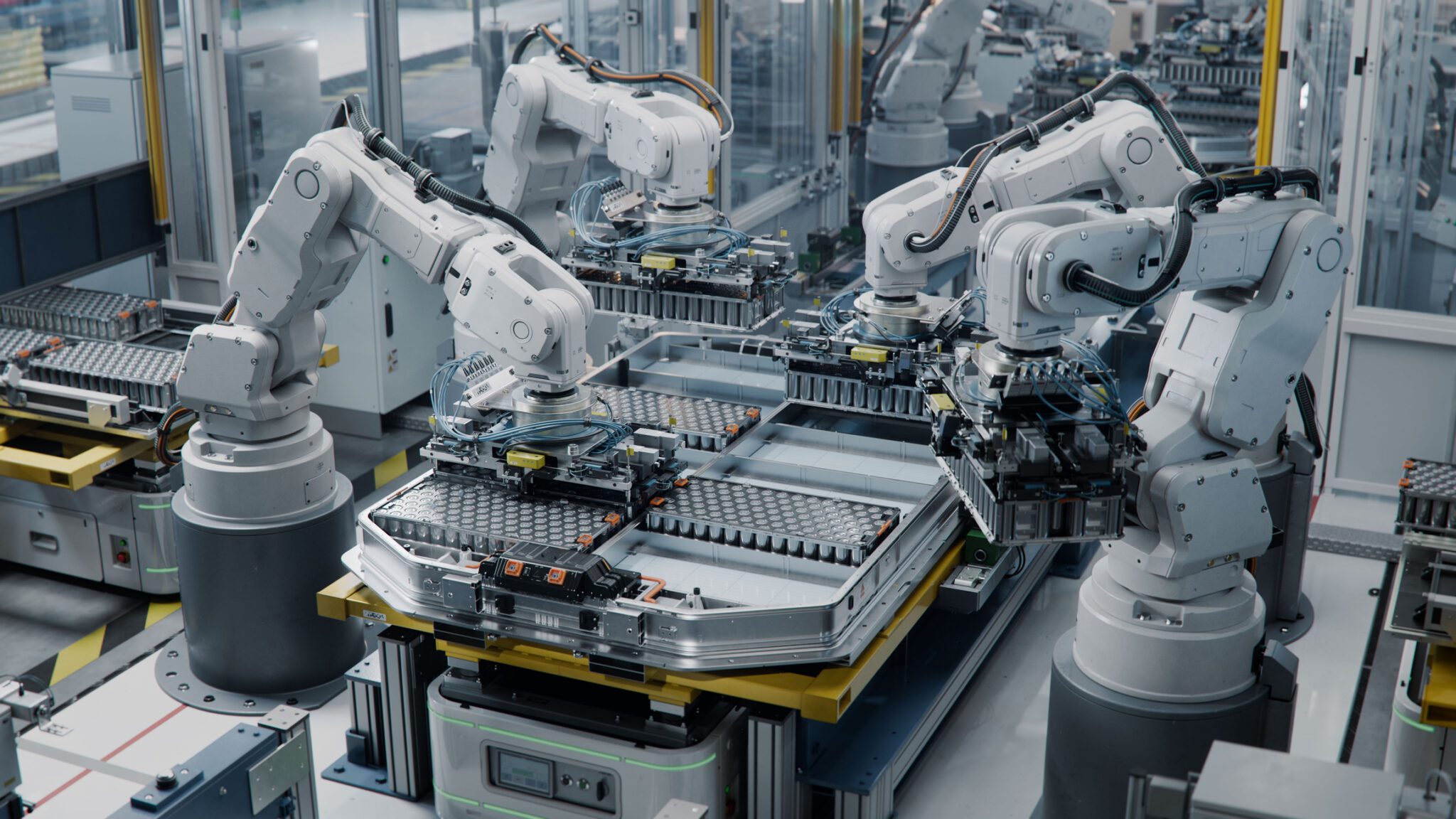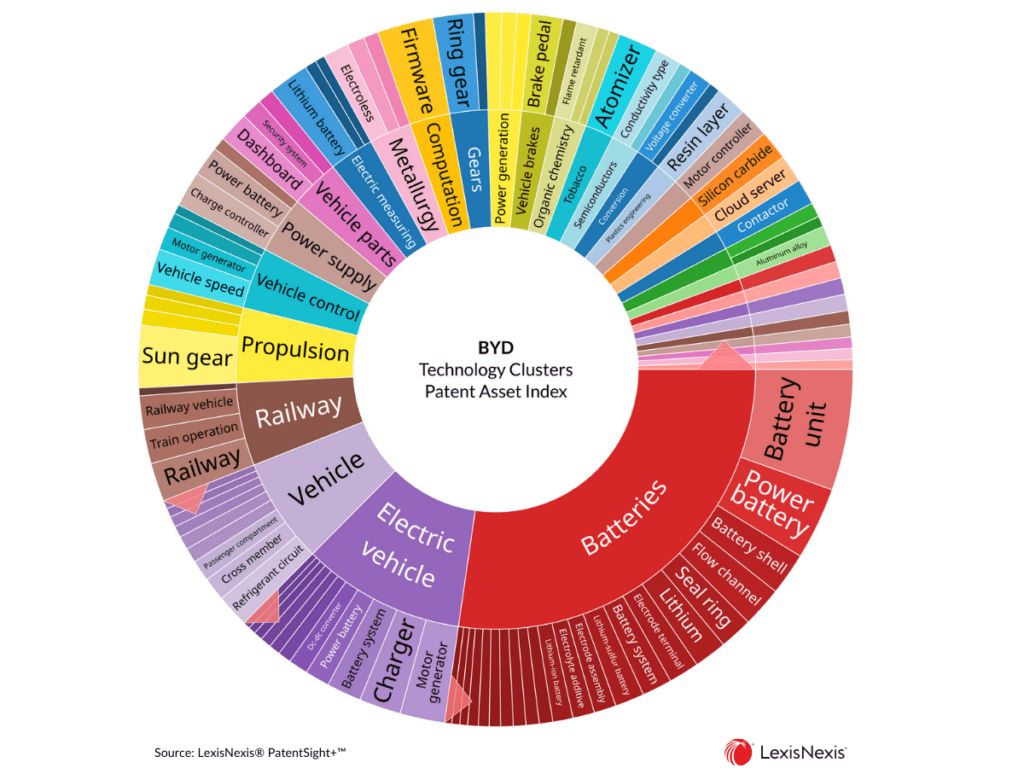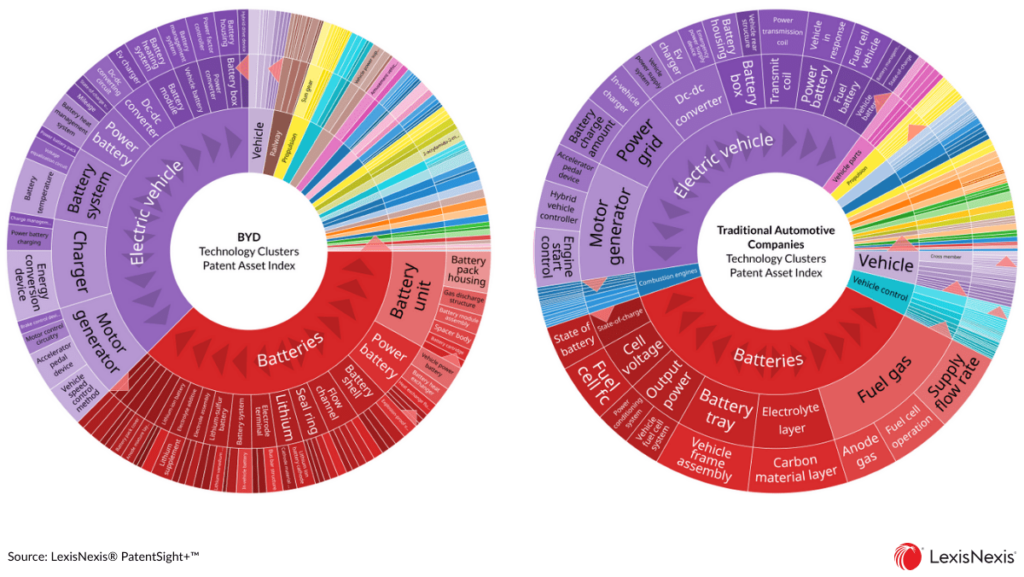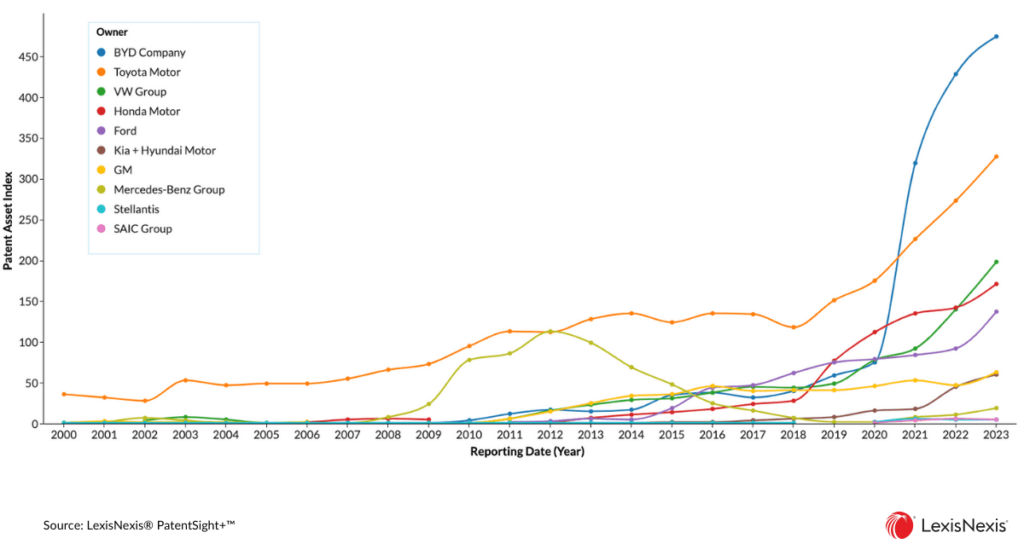Revolutionizing the Automotive Industry

The BYD Battery Technology
The automotive industry is undergoing a transformative shift towards electrification and sustainability. Amidst this evolution, BYD (Build Your Dreams), a Chinese company, has emerged as a global leader in electric vehicles (EVs). Its unique journey from being a battery manufacturer to a comprehensive automotive and energy company sets BYD apart. But how does BYD battery technology stand in the automotive industry from an intellectual property (IP) perspective? Using advanced patent analytics tools like Technology Clusters, and visualizations like the sunburst chart, this analysis dives into the BYD patent portfolio. We compare it with traditional automotive companies that are also venturing into the electric vehicle market.
The latest update of the Technology Clusters in LexisNexis PatentSight+ enhances clustering accuracy and title selection for improved classification and competitive intelligence. Technology Clusters leverages our AI capabilities to provide an unbiased, view of competitors’ patent portfolios, enabling quick exploration within specific tech domains. In this blog, we used the updated Technology Clusters to reveal and break down BYD’s R&D strategies, especially in battery technology.
A unique view of the BYD battery technology patent portfolio

Figure 1: BYD’s Technology Clusters and its strengths measured by the Patent Asset Index.
This analysis focuses solely on the active patent portfolio, measuring its size by the number of active patent families. The sunburst visualization, as seen in Figure 1., illustrates BYD’s technology clusters at the second and third levels of detail. This gives us an overview of the detailed technologies that BYD is innovating.
How technology clustering works
Technology Clusters in PatentSight+ is built on an AI algorithm trained with patent classification data and patent texts. It groups all patents in the PatentSight collection into clusters. PatentSight groups patents into simple families, and each simple patent family is only assigned to a single cluster.
The size of each technology cluster indicates its strength, measured by the Patent Asset Index. In the second level, we get insights into the BYD battery technology patents in the “Batteries” cluster. This is the strongest segment in terms of patent strength, and it includes various battery-related technologies. The “Electric Vehicle” cluster follows closely behind. It might be more interesting to others that BYD’s portfolio includes around 104 active patent families related to tobacco technology, particularly atomizers for e-cigarettes. Such unexpected insights are only revealed at this level of analysis.
Numerous third—and fourth-level technology clusters exist within the “Batteries” cluster. For example, the “Battery Unit” cluster at the third level includes patents related to battery modules, cases, housing and cell assembly. We can also see that within the Batteries cluster is the “Power battery” cluster, which consists of heat-controlling technologies. The “Battery systems” cluster, under “Electric Vehicle,” deals with battery management in the context of EVs.
How the BYD battery technology holds up against traditional automotive companies

Figure 2: Comparing BYD with traditional automotive companies. The Technology Clusters “Batteries” and “Electric vehicles” are fanned out to show the clusters at the third and fourth levels of detail.
To compare BYD battery technology with traditional automotive companies, we analyzed the portfolio strength of the “Batteries” and “Electric Vehicles” technology clusters. We compare BYD to traditional automotive companies: Ford, GM, Honda Motor, Hyundai Motor, Kia, Mercedes-Benz Group, SAIC Group, Stellantis, Toyota Motor, and VW Group.
Interestingly, for these traditional companies, the strongest cluster under “Batteries” is “Fuel Gas,” aggregating patents related fuel gas and battery technologies. The second strongest cluster is “Bipolar Plate”. This cluster holds patents for this fuel cell component. The third strongest cluster, “Electrolyte layer”, comprises patents related to battery components for solid state batteries.
Comparing the portfolio developments of top automotive companies against BYD

Figure 3: The portfolio strength development of “Battery unit” Technology Clusters of BYD and selected traditional automotive companies.
In our analysis, we utilized the expansion of clusters in the sunburst chart. Our goal was to compare the “Battery unit” patent portfolios of traditional automotive companies with BYDs. Figure 3 presents this comparison, using the Patent Asset Index to measure portfolio strength within the cluster “Battery unit”. This shows BYD’s standing against ten traditional players.
The “Battery unit” cluster shows portfolio strength gains for Toyota Motor, Honda Motor, Ford, and BYD since 2018 and 2019. BYD started to rapidly gain in Patent Asset Index, changing from rank 5 to rank 1 in a single year. BYD since then leads the benchmark, with Toyota Motor, Honda Motor, VW Group and Ford trying to catch up with solid growth. This benchmark showcases its significant competitive edge in the technology related to the cluster “Battery unit”.
Mastering fragmented technologies: Why in-depth analysis is crucial for staying competitive
The majority of the clusters in the analysis align with BYD’s battery and electric vehicle business. Additionally, unexpected technologies, such as patents related to e-cigarettes, were also identified. This showcases one of the key advantages of PatentSight+ Technology Clusters to reveal unexpected technology segments. Fuel cell technology emerges as a differentiator in the battery technology field compared with traditional automotive companies. BYD’s strategic emphasis on innovation and IP strength underscores its role in the field. The company is a key player in the automotive industry’s shift towards electrification and sustainability.
Segmenting patent portfolios into technology clusters offers a quick qualitative overview of the technologies covered by their patents. For decision makers, these insights offer the opportunity to identify a potential licensing partner or even spot competitors before they become threats.
If you are interested in finding out how your company compares to your competition in various technology subsegments, contact us here to set up a personalized demo of the analysis.

Log in to PatentSight+
to try out the new
Technology Clusters

